While I’m going to publish a “Complete Guide To United Stopovers” soon, I wanted to first give some context about the current state of United stopovers.
United plans to make some major changes by getting rid of their award chart in November and going to dynamic pricing (where you don’t know the rate until you search). Although it is currently unclear whether or not they plan to do the same for partner flights, or if it will just be United flights. (See details about United Eliminating the Award Chart)
In the meantime, they seem to be testing this by making some domestic flights cheaper than normal. For example, I saw a United New York to Washington flight for only 5,500 miles.
Believe it or not, I think there are positive impacts for those really trying to make the most of their United miles with stopovers.
You might think I’m crazy, but not only do I still think United miles are the best transfer partner of Chase Ultimate Rewards Points by a long shot, I also think they just got a little bit better for stopover enthusiasts.
I’ll quickly gloss over United stopover basics (because I’ll be doing an entire post and have done other posts) to simply give context for the implications of United’s new pricing.
Really United stopovers are free segments branded as “Excursionist Pack”, a term I don’t use. I’ll either refer to the concept as a stopover or a “free segment”.
Most of the United Stopover Rules and tricks I discovered when the program changed to its current version can be found in my post “New United Stopover Rules“.
But the phrase “free segment” is really a better descriptor than a stopover, because it literally prices out each segment and it literally prices out the middle segment as zero miles.
The United Stopover Basics
- Flight must end in the region of origin.
- The free segment must be in a different region than the region of origin.
- The free segment must be completely within a single region.
For example, you could fly to London, and instead of making a roundtrip and coming straight home, you can add a free segment in Europe, like London to Rome, and then fly home.
Diving Into Advanced Stopover Tricks
1) A free segment within any region.
Let’s say you start in Chicago and go to London, your next free segment can be anywhere, it doesn’t have to pick up from London to Rome, it could be Paris to Rome.
Let me work through a bunch of valid examples, but I’ll use hyphens (“-“) as segments and slashes (“/”) as open jaws.
(In other words, Chicago to London, then an open-jaw to Paris (a gap in the ticket where you are responsible for your own transportation, i.e. train, bus, another flight, car rental, walking, etc…) for a Paris to Rome flight would look like this: Chicago – London / Paris – Rome)).
All of now, the following are valid examples (all italicized routes would be free segments):
- Chicago – London / Paris – Rome – Chicago
- Chicago – London / Paris – Rome / Venice – Chicago
- Chicago – London / Paris – Rome / Venice – New York
What’s crazy, is that I’ve found that you don’t actually have to have the free segment in a relevant region. For example, all of the following are valid (all italicized routes would be free segments):
- Chicago – London / Nairobi, Kenya – Cape Town, South Africa / Venice – Chicago
- Chicago – London / Bogota – Galapagos / London – Chicago
Unfortunately, you can’t switch the order of the free flight and just tack on a random flight elsewhere. So you can’t do a roundtrip to London and later tack on a free flight elsewhere.
Remember my first rule “flight must end in the region of origin“, which means you have to end your last segment in the region you started in.
That being said, it’s a pretty loose set of rules. And while it wouldn’t make sense to tack on a free segment in South America in the middle of a roundtrip to Europe, it would make sense to do a lot of other things.
For example, it could make sense to tack on a free flight within Africa if your plan was to take a boat to Morocco, or a flight down to Kenya, or who knows what.
Why the new pricing is relevant
Here’s where this gets crazy.
If you’re familiar with old stopover rules, you might falsely assume that the last segment that has to end in the region of origin has to be an international flight… But it doesn’t.
In other words, any of the following routes are valid routes (all italicized routes would be free segments):
- Washington – London / Paris – Rome / New York – Washington
- Washington – London / Nairobi – Cape Town / New York – Washington
- Washington – New York / Nairobi – Cape Town / New York – Washington
This may sounds completely crazy, but I’ll explain why in many ways it’s not. Let’s unpack it.
Somehow a roundtrip from Washington DC to New York can have a free segment in Africa sandwiched in the middle. This would actually work with any free segment, and it would work with any trip that starts and ends in the same region.
The crazy thing is that this intra-Africa flight would normally cost 20,000 miles, which is more than the the roundtrip in the US would be now, and it shows the segment free:

Crazy, right?
What’s absolutely bonkers, is not just that this 20,000 mile flight can be free with such a non-expensive ticket…
But right now United is practicing its dynamic pricing on these short domestic routes and it prices this short route out at 5,500 miles each way when I booked as part of this “roundtrip”.
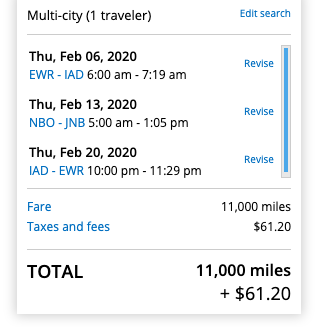
The screenshot above is the following:
- New York – DC = 5,500 miles
- Nairobi, Kenya – Johannesburg, South Africa = 0 miles
- DC – New York = 5,500 miles
That means a domestic flight and a segment within Africa (which is normally 20,000 miles alone) comes out to 11,000 United miles.
This concept works in any combination.
A free segment could be in Asia, the Middle East, the Caribbean, or anywhere. It could be in the middle of a roundtrip to Hawaii, the Caribbean, Europe, or anywhere.
As long as it starts and ends in the same region and as long as the last flight ends in the region it started in.
Practical Applications
First of all, with those concepts, it really means there are near unlimited combinations possible for this free segment.
And because the free segment in the example above is more valuable than the free flight, you don’t really have to take the second flight to get plenty of value out of this. (If you even skip a flight, the rest of your ticket is usually canceled, so never skip a flight on a ticket where you have later segments).
As long as you could use a flight within a region, and you can take the first 5,500 mile flight, this concept is useful.
It could even be an open-jaw on another United mile flight.
It also doesn’t have to be a really broken up ticket.
The concepts work in any class.
United will give you the option of a free (0 mile) segment up to the class of the previous segment.
If the previous flight was US to Europe in Business, then your free intra-Europe segment (or wherever your free segment is) will be free for economy or business class.
For example, you could do the following:
- DC – Nairobi: in business class (80,000 miles)
- Nairobi – Cape Town: in business class (0 miles)
- New York – DC: in economy (5,500 miles)
Total is 85,500 miles. Regardless of whether or not you need to fly the last domestic leg, you’d surely pay 5,500 United miles to get an intra-Africa flight in Business Class for free.
A free 11 hour business class flight:
The amazing thing about United’s new dynamic pricing for domestic flights is that any flight starting in the US can now add a stopover (or rather, a free segment) for 5,500 United miles.
Why The Crazy Open-Jaw Could Be Practical
It might look crazy to have an Intra-Africa flight in between a domestic flight, but I can think of a dozen practical uses for the average miles collector. (And remember, intra-Africa is just an example and it could be within any region).
After all, recently I posted about many deals that only start in New York or east coast cities in my post on Best Use of Etihad Miles (on Partners).
For example, I mentioned Flights on Royal Air Maroc to all over Africa and the Middle East for only 44,000 miles in Business Class (or 22,000 miles in economy).
Or heck, as I mentioned in my recent post on Finding The Best Alaska Stopovers that you can get to South Africa on Cathay Pacific (with a stopover in Hong Kong) for only 70,000 miles in first class!
You could use the ticket above to get there and one of the other options to get home. Or use the Air Maroc option oneway, and the Cathay option to get home, and the free segment to connect them.
Therefore you can use the domestic United segments to get to New York for these flights that don’t allow you to mix partners anyways, and therefore leaving you in need of a domestic flight.
Or you could break up the ticket into multiple tickets.
Perhaps you start at home and take a flight to Hawaii using United miles, and then get a flight home from Hawaii on another airline.
Then you could take a flight within the Middle East 9 months later. And as long as you have a segment ending in the US (like NYC to DC for 5,500 miles), the Middle East segment is free.
Therefore the flight would look like this:
- Any US city – Hawaii = 22,500 miles
- [Another flight with other airline miles home]
- [A flight to the Middle East in 9 months]
- Intra-Middle East Flight = 0 miles
- New York – DC = 5,500 miles
And if you made that first US – Hawaii flight a business class flight, the free segment in the Middle East (or anywhere) could be business class too.
Conclusion
These new 5,500 United mile tickets mean that you can get free segments in many places for less than the domestic flight.
If you’re a little lost though, again, I will post a “Complete Guide To United Stopovers”, and it will include a new little trick for those who want the free segment to be in Business Class.


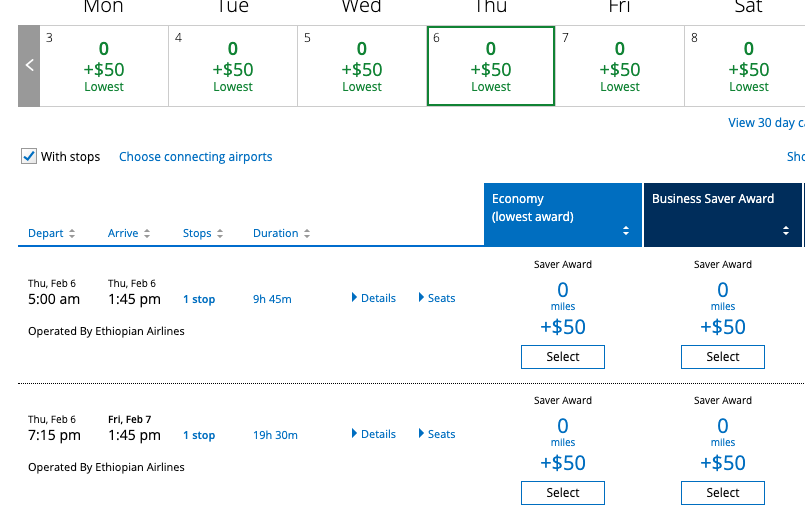
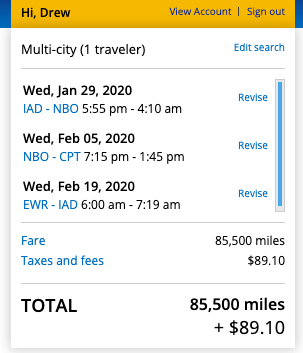
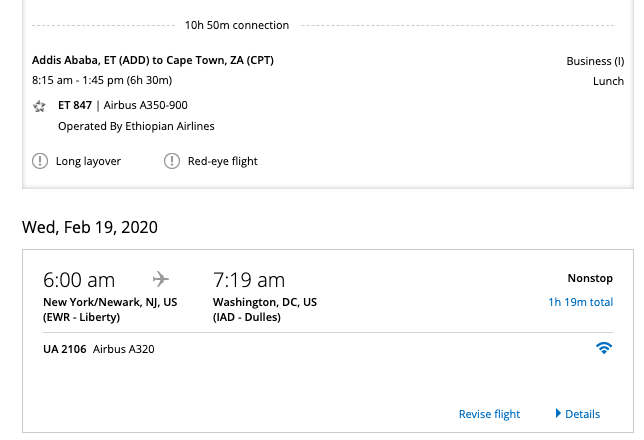

![The [Only] United MileagePlus Award Chart](https://travelisfree.com/wp-content/uploads/2019/04/United-MileagePlus-United-Airlines-Award-Chart-120x86.jpg)
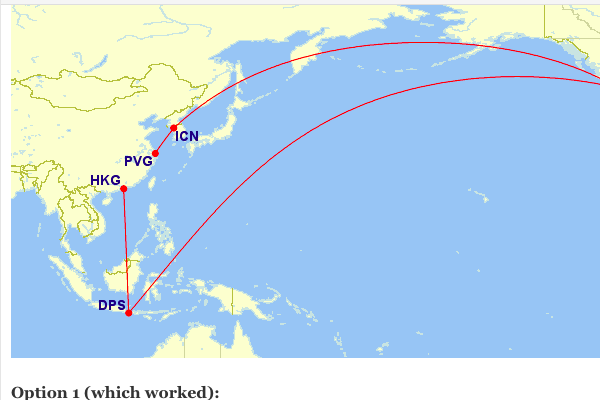
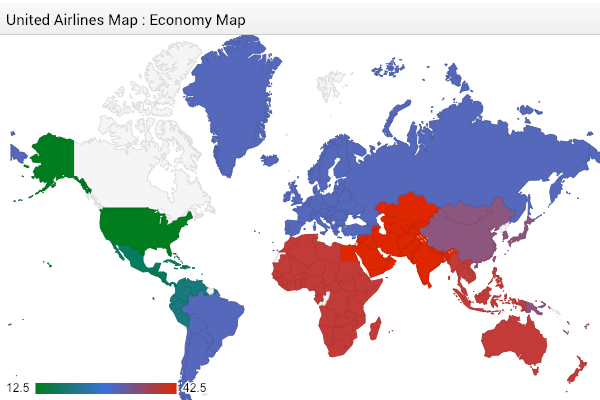
thanks for the deep dive! one small thing – the silly United term is excursionist perk, not pack.
Glad you enjoyed it. Thanks!
Great stuff, Drew. Maybe that next post (“Complete Guide”) should go out as an email, though?… haha
Thanks. All of it’s on my site now anyway. 🙂
awesome work. look forward to hearing more
Thanks!
In your DC-Nairobi in business class example that ends with NY-DC in economy, you state “Regardless of whether or not you need to fly the last domestic leg, you’d surely pay 5,500 United miles to get an intra-Africa flight in Business Class for free.” What would United do if you do not take the NY-DC segment?
Cancel your ticket?
In theory, skipping the flight is a violation if the airline contract of carriage. Some airlines will try to go after you and/or close your mileage account if you make it a habit of skipping flights. (This is why the advice is that if you’re going to skip flights, don’t put in a mileage number with that airline..
At most, use a partner airline’s program to make it harder for the airline to track/go after you.
Just a fair warning, but this is a great article nonetheless. 🙂
The NY-DC segment is the last segment. It would be no big deal if they canceled the ticket, as that segment would be added just to lower the award price and deliberately not be taken. I was wondering if United might recalculate the award price and deduct the additional miles from my account.
Nice! Never though about that free segment like this. My partner told me this morning that I definitely needed to read your post; I’m glad he did.
Awesome! I rarely meet couples that are both into miles and points! Super cool. Do you guys divide and conquer programs? 😀
Excellent material and I’ll read the complete guide with interest. While people have done fun things with the “excursionist perk” and United hasn’t cared, I do wonder whether this opportunity on a really cheap miles ticket is going to last.
Well, it seems they will overhaul the entire program at some point, likely November. I’m guessing they’ll copy Delta’s program a bit more.
This is exactly the way I am going to use United miles moving forward. No longer will I be able to rely on LAX-East coast being a fixed 12.5K United miles due to the new changes, but I’m certain I can find really cheap LAX-LAS-LAX RT award tickets and space the legs to add a free segment in another region.
Also, another note, but you can find flights as low as 5K United miles. I priced out LAX-LAS // DSS-JNB-CPT // LAS-LAX for 10K miles (+ $77 in fees) total
Well, you currently can get 12.5k coast to coast, right? But we’ll see what happens.
But yeah, that’s a great deal! And the Africa example is a fantastic value. And it works with African islands.
Yeah, I’ve seen cheap flights to DEN-LAS, LAX-SFO, etc… But that may be the cheapest.
Seems it depends on the date too.
I’m sure you know but just in case you didn’t use VS award chart to fly SA to DSS for 25k in J.
Drew, maybe this can be a post idea for future? VS award chart for partners, there are a few gems there too.
This site, yet again, does credit to travel blogging. Instead of bloviating about how awful UA’s latest changes are and how they will cause the sky to fall and wipe out the entire frequent-flyer industry, TRAVEL IS FREE has looked at the bright side to try to make the most of changes that are going to happen whether or not we are ready. Changes are inevitable in any industry as adjustments or adaptations to technological/economic/societal/political changes. The best way to survive the “inevitable” is to adapt to it by trying to figure out how it could work for you rather than against you. That is what this site has done yet again, while other travel bloggers have been bloviating…
UA stopovers offer tremendous opportunities, many of which can even come by accidentally: on a recent single multi-city/multi-region redemption I scored two ‘excursion perks’, with the second coming unexpectedly!
G’day!
“on a recent single multi-city/multi-region redemption I scored two ‘excursion perks’, with the second coming unexpectedly!”
Do tell
excellent use of the word bloviate!
Hey Drew,
Another great article! I was playing around with some of the stopover stuff and came up with this albeit two separate awards. Also from my home base at pdx.
6/7 PDX-SFO (award 1)
6/9 SFO-PDX (award 2)
9/4 DSS-CPT (award 1)
9/11 CPT-DSS (award 2)
11/12 PDX-LAX (award 2)
11/13 LAX-PDX (award 1)
award 1 total = 14.5K + $123
award 2 total = 14.5K + $57
3 total rt’s including a ton of flying in Africa for 29K and $180… pretttttttty interesting.
I love this and it was my exact thinking as long as it’s around. Fingers crossed they still don’t care about you guys 😛
Great work. Obviously, this trick could be useful. But I think that even if you are aware of (and understand) the trick, the logistics are still very complicated. So I don’t think it will be too popular — which might keep it alive! As a UA 1K, I guess I’d get extra flexibility because I could change my flights without penalty.
I’m having trouble figuring out United’s definition of a region, for purposes of the free intermediary flight. NRT doesn’t seem to be in the same region as anywhere but another Japanese airport. Baku doesn’t seem to be in any region whatsoever. Hawaii is its own Region. Where’s the answer to this?
Great stuff. Love the breakdown and you are amazing!
Any idea why the ORD/STL flight is not pricing out at zero:
KIX/HND
ORD/STL
HND/KIX
Seems to meet all requirements, perhaps I’m misunderstanding.
Just tested it, and it worked for me. Can you give more details on what you’re doing/searching? Maybe tweet me a screenshot of your search field? @travelisfree
Update: Actually, I think I know what’s happening:
1) United is probably merging Economy “Saver” and Economy “Everyday” in the same column.
2) Your free segment can be upto the same award type.
3) The first segment in Japan is probably a saver award (obviously, cuz it’s on a partner), and I bet United is showing it’s “everyday” not saver awards, which wouldn’t be eligible for the free stopover.
Thank you for the reply. Yes, you are correct, that’s exactly why it’s not pricing out as free. When I look at the 30 day calendar I see other days pricing at zero 🙁
I’m finding that 6K segments price out at 10K when you add them as the last segment. Are you finding that too?
I just stumbled on the exact same thing. If you search individual flight, it is 5.5k, once you piece it into multi-city tool, it is suddenly priced 10k